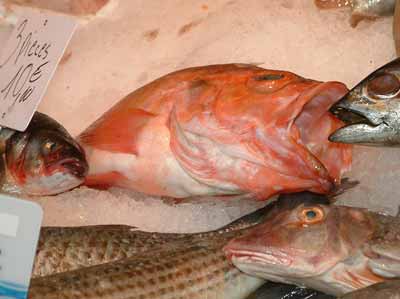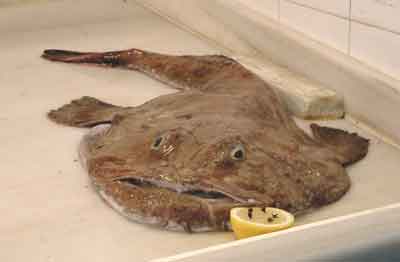
Bluemouth. A type of rascasse from deep North American waters and the western Mediterranean. It has a blue flash on the gill covers and enormous eyes. It is an unsightly fish with good flavour and is used in bouillabaisse and other fish soups.
Salema. A prime, bream-like, food fish found in warmer waters of the Atlantic, the Pacific and Indian Ocean.
Flat lobster. A variety of lobster with a flat tail, shaped somewhat like a slipper, which is the edible part. It makes a noise like a cricket. The Mediterranean slipper lobster is generally used for flavouring soups as it does not carry much meat.
Flat lobster. A variety of lobster with a flat tail, shaped somewhat like a slipper, which is the edible part. It makes a noise like a cricket. The Mediterranean slipper lobster is generally used for flavouring soups as it does not carry much meat.
A name in Bermeo for the alose ir allis shad. This is a freshwater shad, from a family of white, migratory fish. The shad is a bony, tasty, oily fish similar to herring, which travels up rivers in spring and is found in deep lakes. In France it is found in the Gironde where it is often grilled over vine shoots or stuffed with sorrel, and in the Loire, where it may be stuffed with beurre blanc. The roe is a great delicacy and shad is also used raw in sushi. Members of the family include Allis shad (Alosa alosa) and the smaller twaite shad or gizzard shad (Alosa fallax).

A name in Bermeo for the monkfish (US: angler fish). A fish with a sweet flavour and succulent firm flesh but with the ugliest appearance imaginable. It is found in the Mediterranean and Atlantic, in coastal waters of north western Europe. It can be recognised by its large head and fan-shaped fins. The fins and the operculum are spiny. It can be eaten fried or in soup. The larger fish often have better flavour. It has a hideous head, which is why it is usually displayed without it, and a muddy colour. It is known as the anglerfish as it bears on its head a 'rod' and 'lure' which attract its prey. The meat of the tail is sweet and succulent - almost like lobster meat, entirely compensating for is appearance. The flavour may well be assisted by its own diet which is high in shellfish. The best monkfish are Lophius piscatorius and the similar Lophius budegassa, the favourite of the Spanish. American monkfish or goosefish (Lophius americanus) is considered inferior, while New Zealand monkfish (Kathetostoma giganteum) is related to the stargazer and is only fit for soup.